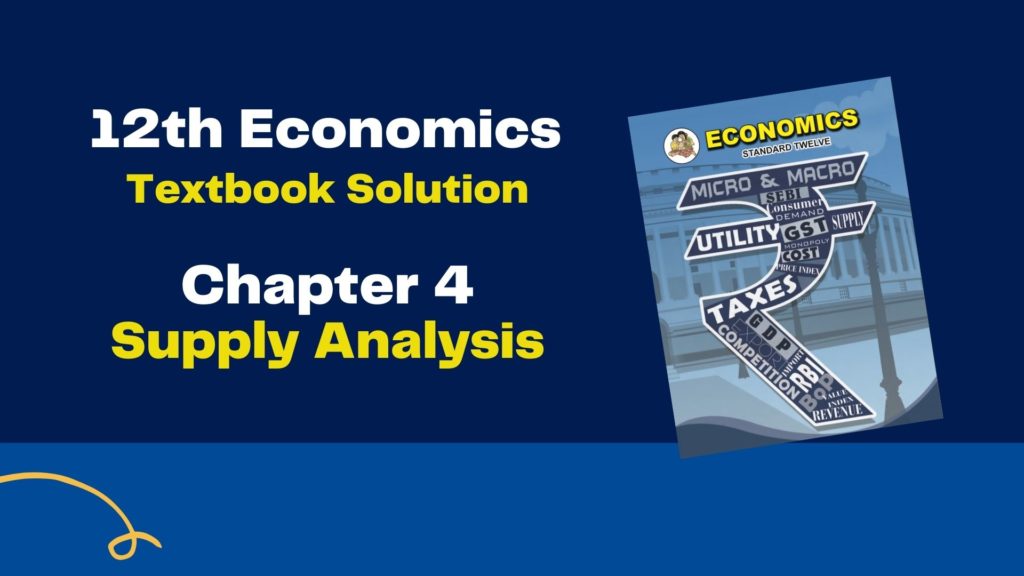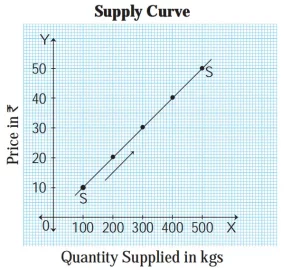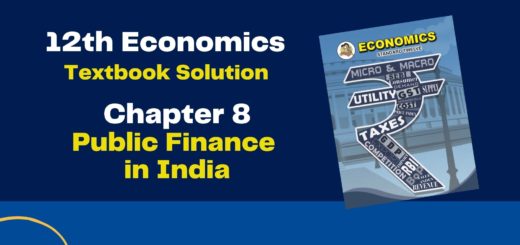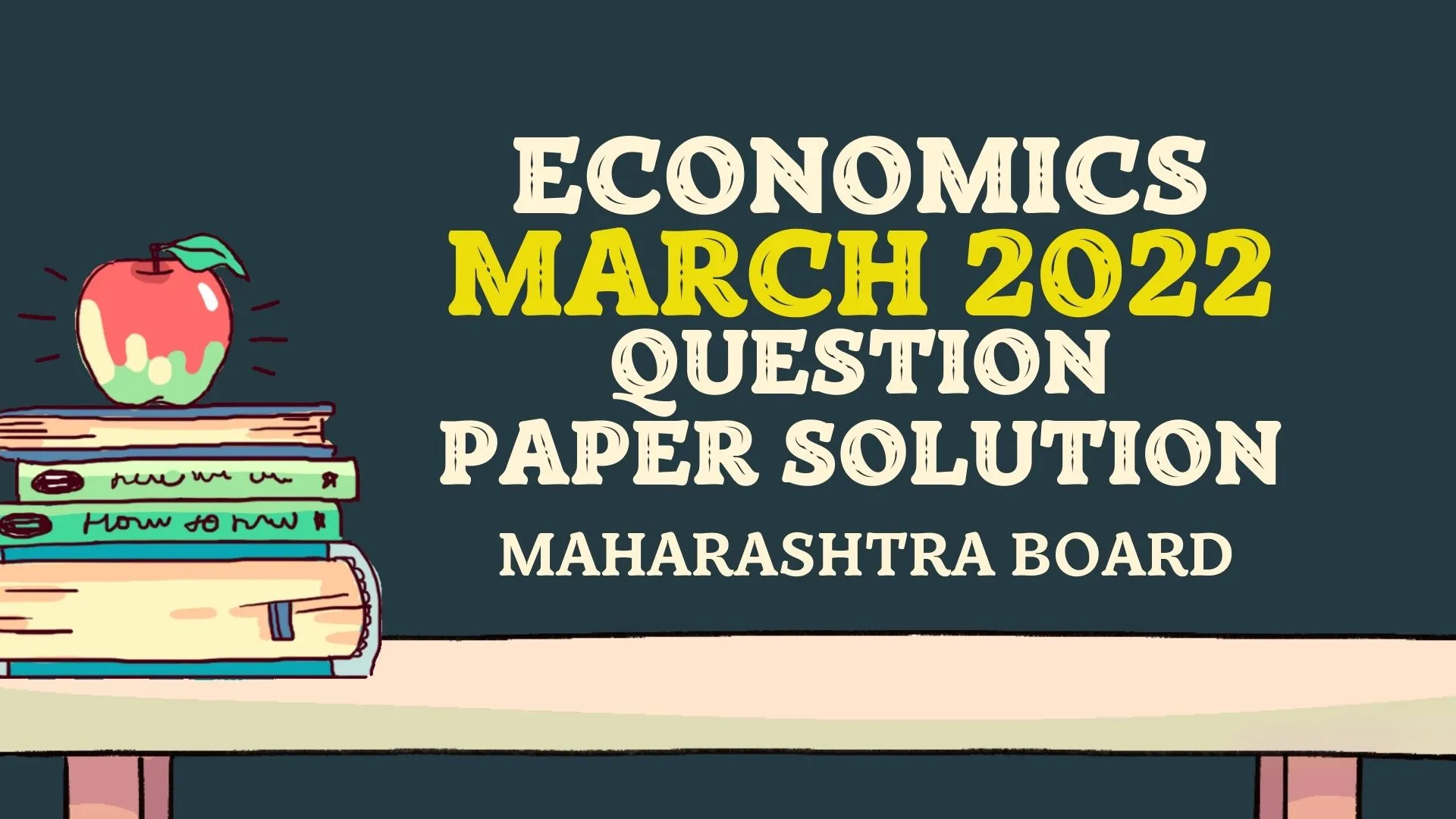12th Economics Chapter 4 Exercise (Supply Analysis) Maharashtra Board – Free Solution
Table of Contents
12th Economics Chapter 4 Exercise

Chapter 4 – Supply Analysis
Q. 1. Complete the following statements
1) When supply curve is upward sloping, it’s slope is _____.
a) positive
b) negative
c) first positive then negative
d) zero
2) An upward movement along the same supply curve shows _____.
a) contraction of supply
b) decrease in supply
c) expansion of supply
d) increase in supply
3) A rightward shift in supply curve shows _____.
a) contraction of supply
b) decrease in supply
c) expansion of supply
d) increase in supply
4) Other factors remaining constant, when less quantity is supplied only due to a fall in price, it shows _____.
a) contraction of supply
b) decrease in supply
c) expansion of supply
d) increase in supply
5) Net addition made to the total revenue by selling an extra unit of a commodity is _____.
a) total Revenue
b)marginal Revenue
c)average Revenue
d)marginal Cost
Q. 2. Complete the correlation
1) Expansion of supply : Price rises : : Contraction of supply : Price falls
2) Total revenue : P X Q : : Average revenue : TR/TQ
3) Total cost : TFC + TVC : : Average cost : TC/TQ
4) Demand curve : Downward : : Supply curve : Upward
5) Price constant : Change in supply : : Other factors constant : Variation of Supply
Q. 3. Give economic terms
1) Cost incurred on fixed factor.
Answer: Fixed Cost
2) Cost incurred per unit of output.
Answer: Average Cost
3) Net addition made to total cost of production.
Answer: Marginal Cost
4) Revenue per unit of output sold.
Answer: Average Revenue
Solution of other subjects
Solution of all Chapters of Economics
1 – 2 – 3A – 3B – 4 – 5 – 6 – 7 – 8 – 9 – 10
Q.4. Distinguish between
1) Stock and Supply.
| Points | Stock | Supply |
| 1)Meaning | Stock is the total quantity of commodities available for sale with a seller at a particular point of time. | The word ‘supply’ implies the various quantities of a commodity offered for sale by producers during a given period of time at a given price. |
| 2) Interrelationship | Normally, stock exceeds supply but in the case of perishable goods stock may be equal to supply. | Supply and stock can be same, but supply cannot exceed stock. |
2) Expansion of Supply and Increase in Supply.
| Points | Expansion of Supply | Increase in Supply |
| 1)Meaning | Expansion of supply refers to a rise in the quantity supplied due to a rise in the price of a commodity, other factors remaining constant. | Increase in supply refers to rise in the supply of a given commodity due to favourable changes in other factors, while price remains constant. |
| 2) Curve movement | Expansion in supply leads to an upward movement on the same supply curve due to a rise in price. | The supply curve shifts to the right of the original supply curve. |
3) Contraction of Supply and Decrease in Supply.
| Points | Contraction of Supply | Decrease in Supply |
| 1) Meaning | Contraction of supply refers to a fall in the quantity supplied, due to fall in the price of commodity, other factors remaining constant. | Decrease in supply refers to a fall in the supply of a given commodity due to unfavourable changes in other factors while price remains constant. |
| 2) Curve movement | In case of contraction of supply, there is a downward movement on the same supply curve. | The supply curve shifts to the left of the original supply curve. |
4) Average Revenue and Average Cost.
| Points | Average Revenue | Average Cost |
| 1) Meaning | Average revenue is the revenue per unit of output sold. | Average cost refers to the cost of production per unit. |
| 2) Formula | AR = TR / TQ AR = Average Revenue TR= Total Revenue TQ =Total Quantity | AC = TC / TQ AC = Average cost TC = Total cost TQ = Total quantity |
Q.5. Observe the following table and answer the questions
A) Supply schedule of chocolates
1) Complete the supply schedule.
| Price in Rs. | Quantity supplied in units |
| 10 | 200 |
| 15 | 250 |
| 20 | 300 |
| 25 | 350 |
| 30 | 400 |
| 35 | 450 |
| 40 | 500 |
2) Draw a diagram for the above supply schedule.
3) State the relationship between price and quantity supplied.
B) Observe the market supply schedule of potatoes and answer the following questions.
1) Complete the quantity of potato supplied by the firms to the market in the below table.
| Price in Rs | Firm A | Firm B | Firm C | Market supply(kg) |
| 1 | 35 | 20 | 45 | 100 |
| 2 | 37 | 30 | 45 | 112 |
| 3 | 40 | 40 | 55 | 135 |
| 4 | 44 | 50 | 60 | 154 |
2) Draw the market supply curve from the schedule and explain it.
Solution of other subjects
Solution of all Chapters of Economics
1 – 2 – 3A – 3B – 4 – 5 – 6 – 7 – 8 – 9 – 10
Q.6. Answer the following questions
1) Explain the concept of total cost and total revenue.
Answer:
1) Total Cost (TC):
Total cost is the total expenditure incurred by a firm on the factors of production required for producing goods and services. Total cost is the sum of total fixed cost and total variable cost at various levels of output.
TC = TFC + TVC
TC = Total cost
TFC = Total Fixed Cost
TVC = Total Variable Cost
Total Fixed Cost (TFC): Total fixed costs are those expenses of production which are incurred on fixed factors such as land, machinery, etc.
Total Variable Cost (TVC): Total variable costs are those expenses of production that are incurred on variable factors such as labour, raw material, power, fuel etc.
1) Total Revenue (TR):
Total revenue is the total sales proceeds of a firm by selling a commodity at a given price. It is the total income of a firm. Total revenue is calculated as follows:
Total revenue = Price × Quantity
For example, if a firm sells 15 units of a commodity at ₹ 200 per unit TR is calculated as
TR = P × Q
= 200 × 15
= ₹ 3000
2) Explain the determinants of supply.
Answer:
The following are the determinants of Supply :
1) Price of commodity:
Price is an important factor influencing the supply of a commodity. More quantities are supplied at a higher price and less quantities are supplied at a lower price. Thus, there is a direct relationship between price and
quantity supplied.
2) State of technology:
Technological improvements reduce the cost of production which lead to an increase in production and supply.
3) Cost of Production:
If the factor price increases, the cost of production also increases, as a result, supply decreases.
4) Infrastructural facility:
Infrastructure in the form of transport, communication, power, etc. influences the production process as well as supply. Shortage of these facilities decreases the supply and vice versa.
5) Government policy:
Favourable Government policies may encourage supply and unfavourable government policies may discourage the supply. Government policies like taxation, subsidies, industrial policies, etc. may encourage or discourage production and supply, depending upon government policy measures.
6) Natural conditions:
The supply of agricultural products depends on the natural conditions. For example, a good monsoon
and favourable climatic condition will produce a good harvest, so the supply of agricultural products will increase and unfavourable climatic conditions will lead to a decrease in supply.
7) Future expectations about price:
If the prices are expected to rise in the near future, the producer may withhold the stock. This will reduce the supply and vice versa
8) Other factors:
It includes,
• nature of the market,
• relative prices of other goods,
• export and imports,
• industrial relations,
• availability of factors of production etc.
If all factors are favourable, supply of a commodity will be more and vice versa.
Q.6. Answer the following questions
3) State and explain Law of Supply with exceptions.
Answer:
Law of Supply
Introduction :
The law of supply is also a fundamental principle of economic theory like law of demand. Prof. Alfred Marshall introduced it in his book, ‘Principles of Economics’ which was published in 1890. The law explains
the functional relationship between price and quantity supplied.
Statement of the Law :
“Other things being constant, higher the price of a commodity, more is the quantity supplied and lower the price of a commodity less is the quantity supplied”
In simple words, “other factors remaining constant, a rise in price results in a rise in the quantity supplied and vice-versa. Thus, there is a direct relationship between price and quantity supplied.
Symbolically,
Sx = f (Px)
S = Supply
x = Commodity
f = Function
P = Price of commodity
The law of supply is explained with the help of the following schedule and diagram
| Price of commodity x (in ₹) | Supply of commodity x (in kgs.) |
| 10 | 100 |
| 20 | 200 |
| 30 | 300 |
| 40 | 400 |
| 50 | 500 |
The above table explains the direct relationship between price and quantity of commodity supplied. When price rises from ₹10 to ₹20, ₹30, ₹40 and ₹50, the supply also rises from 100 to 200, 300, 400 and 500 units respectively.
It means, when price rises supply also rises and when price falls supply also falls. Thus, there is direct relationship between price and quantity supplied which is shown in the following figure:

In the above figure, the X-axis represents quantity supplied and Y axis represents the price of the commodity. Supply curve ‘SS’ slopes upwards from left to right which has a positive slope. It indicates a direct relationship between price and quantity supplied.
Exceptions to the Law of Supply :
Following are the exceptions to the law of supply:
1) Supply of labour:
Labour supply is the total number of hours workers work at a given wage rate. It is represented graphically by a supply curve. In case of labour, as the wage rate rises the supply of labour (hours of work) would increase. So supply curve slopes upward. Supply of labour (hours of work) falls with a further rise in wage rate and supply curve of labour bends backward. This is because the worker would prefer leisure to work after receiving higher wages. Thus, after a certain point when wage rate rises the supply of labour tends to fall.
2) Agricultural goods:
The law of supply does not apply to agricultural goods as they are produced in a specific season and their
production depends on weather conditions. Due to unfavourable changes in weather, if agricultural production is low, their supply cannot be increased even at a higher price.
3) Urgent need for cash:
If the seller is in urgent need for hard cash, he may sell his product at which may even be below the market price.
4) Perishable goods:
In the case of perishable goods, the supplier would offer to sell more quantities at lower prices to avoid losses. For example, vegetables, eggs etc.
5) Rare goods:
The supply of rare goods cannot be increased or decreased according to its demand. Even if the price rises, supply remains unchanged—for example, rare paintings, old coins, antique goods, etc.
Solution of other subjects
Solution of all Chapters of Economics
1 – 2 – 3A – 3B – 4 – 5 – 6 – 7 – 8 – 9 – 10
Extra Questions
(1) Total revenue and marginal revenue.
| Total revenue | Marginal revenue. |
| Total revenue is the total sales proceeds of a firm by selling a commodity at a given price. | Marginal revenue is the net addition made to total revenue by selling an extra unit of the commodity. |
| Total revenue = Price × Quantity | MRn = TRn – TRn-1 |
Solution of other subjects
Solution of all Chapters of Economics
1 – 2 – 3A – 3B – 4 – 5 – 6 – 7 – 8 – 9 – 10
Solution of all Chapters of Economics
| Chapter Name | Solution Link |
| 1) Introduction to Micro and Macro Economics | Click Here |
| 2) Utility Analysis | Click Here |
| 3A) Demand Analysis | Click Here |
| 3B) Elasticity of Demand | Click Here |
| 4) Supply Analysis | Click Here |
| 5) Forms of Market | Click Here |
| 6) Index Numbers | Click Here |
| 7) National Income | Click Here |
| 8) Public Finance in India | Click Here |
| 9) Money Market and Capital Market in India | Click Here |
| 10) Foreign Trade of India | Click Here |
Check out other posts related to the 12th Commerce
| Textbook Solutions of 12th Commerce (All Subjects) | Click Here |
| Free pdf of 12th Commerce Textbooks | Click Here |
| 12th Commerce IT MCQ Preparation (Online Test) | Click Here |
| 12th Commerce Paper Pattern and Chapter Wise Marks Distribution | Click Here |
| Sample Paper of 12th Commerce for Practice | Click Here |
| Solved Sample papers of 12th Commerce to improve Paper Presentation | Click Here |
| Old Question Papers of 12th Commerce with solution (All Subjects) | Click Here |



Explain determinants of supply. answer wrong hai